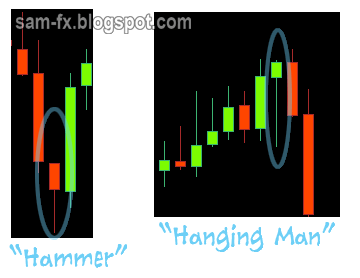In my previous post I have describe the anatomy of a candlestick, and also the Doji candlestick. There are many more candlestick patterns out there; there are even more candlestick formation out there to study. Here I would highlight some of the more common candlestick patterns for you.
The Doji have been mentioned in the previous blog. Its one of the most significant candlestick patterns out there.
The Marubozu (まるぼず)
The Marubozu is a candle with long body and no shadow/wicks. Sometimes there will be shadow but usually its very short. If Marubozu candlestick is real person, it will be like “Yao Ming” in the real world, very tall.
The Marubozu usually means the bullish/bearish trend is strong, and usually (but not always) signal a continuation. Marubozu with shadow are significant too, usually the shadow are short. A “closing Marubozu” have stronger meaning then an “opening Marubozu”. A “closing Marubozu” is a Marubozu which have a short shadow only at the the opening end; and vice versa for the “opening Marubozu”.
Spinning tops
These are candlestick that similar to a Doji. The difference is they have a very small body (oppose to Doji which do not have a body) and a very long top/bottom shadow.
The appearance of spinning tops after a trend means the trend is weakening. It might be a sign of reversal. Using it with indicators will give you higher accuracy on spotting a reversal.
Hammer / Hanging man
A hammer or hanging man candlestick looks the same. They have a very long lower shadow; very short or non-existence upper shadow, and a very small body. They can be black or white (red or green) candles. We call them “hammer” when they appear at end of downtrend, and we call them “hanging man” when they appear at end of up trend.
Usually the appearance will signal a reversal. But we will need to wait for confirmation candlestick and also with help of indicators.
Inverted hammer / shooting star
These 2 candles are the same. They have very long upper shadow, a very short body, and very short or non-existence lower shadow. We call them “inverted hammer” when they appear in downtrend, and we call them “shooting star” when they appear in uptrend.
Usually their appearance will signal a reversal. But we will wait for a confirmation candle, and also with the help of indicators.
There you go, few of the more common candlesticks. At next post we will goes into candlestick formation.
Here are some readings to boost your knowledge on candlesticks.
The Doji have been mentioned in the previous blog. Its one of the most significant candlestick patterns out there.
The Marubozu (まるぼず)
The Marubozu is a candle with long body and no shadow/wicks. Sometimes there will be shadow but usually its very short. If Marubozu candlestick is real person, it will be like “Yao Ming” in the real world, very tall.
The Marubozu usually means the bullish/bearish trend is strong, and usually (but not always) signal a continuation. Marubozu with shadow are significant too, usually the shadow are short. A “closing Marubozu” have stronger meaning then an “opening Marubozu”. A “closing Marubozu” is a Marubozu which have a short shadow only at the the opening end; and vice versa for the “opening Marubozu”.
Spinning tops
These are candlestick that similar to a Doji. The difference is they have a very small body (oppose to Doji which do not have a body) and a very long top/bottom shadow.
The appearance of spinning tops after a trend means the trend is weakening. It might be a sign of reversal. Using it with indicators will give you higher accuracy on spotting a reversal.
Hammer / Hanging man
A hammer or hanging man candlestick looks the same. They have a very long lower shadow; very short or non-existence upper shadow, and a very small body. They can be black or white (red or green) candles. We call them “hammer” when they appear at end of downtrend, and we call them “hanging man” when they appear at end of up trend.
Usually the appearance will signal a reversal. But we will need to wait for confirmation candlestick and also with help of indicators.
Inverted hammer / shooting star
These 2 candles are the same. They have very long upper shadow, a very short body, and very short or non-existence lower shadow. We call them “inverted hammer” when they appear in downtrend, and we call them “shooting star” when they appear in uptrend.
Usually their appearance will signal a reversal. But we will wait for a confirmation candle, and also with the help of indicators.
There you go, few of the more common candlesticks. At next post we will goes into candlestick formation.
Here are some readings to boost your knowledge on candlesticks.




